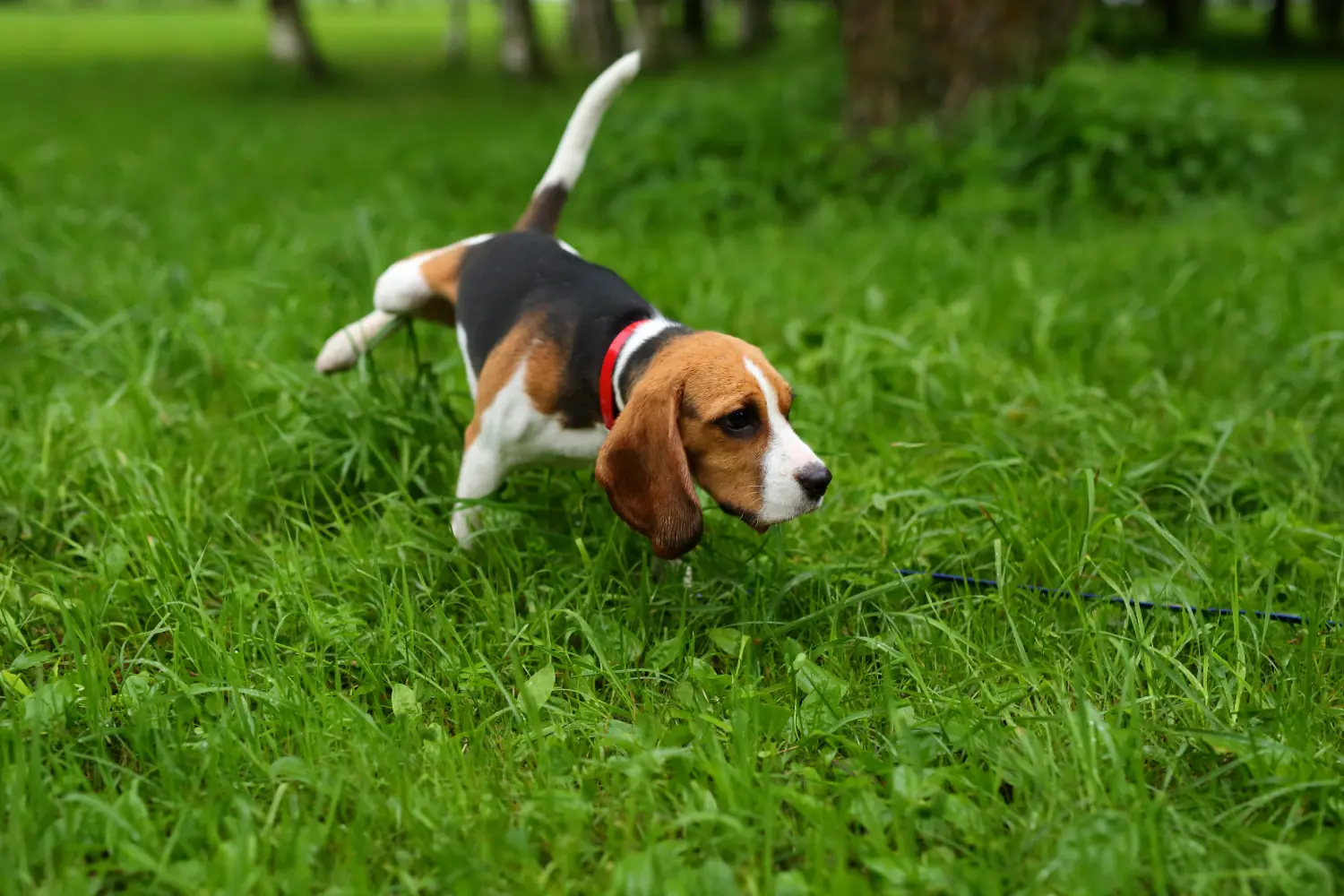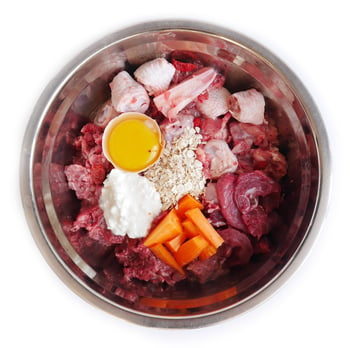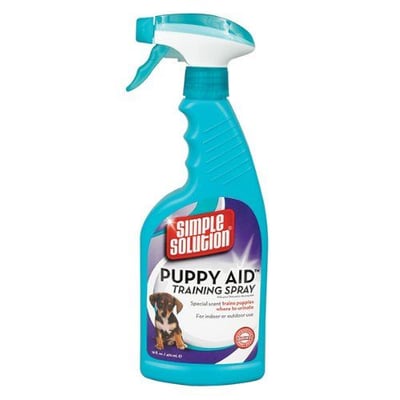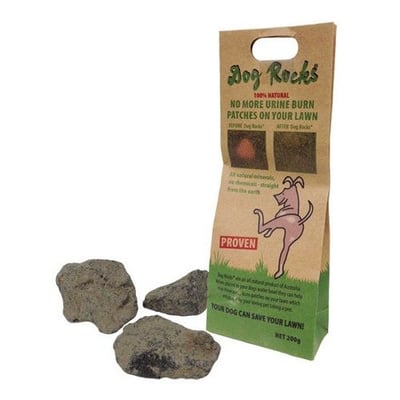
Have you ever peered over the fence at your neighbour's lawn and thought, "Hey, the grass actually is greener on the other side!" Don't worry, you are not alone in this struggle. In this post, you can learn why does dog pee kill grass and get simple tips to help revive damaged grass.
When you look out onto your patchy lawn, you may be wondering - Does dog pee kill grass? Why does dog pee kill grass? How can I prevent pet urine from killing my lawn?
Pet owners all want a beautiful, lush, green lawn for their dogs to frolic in, but the reality is that it’s more common to have large yellow patches of damaged grass and dirt because of dog pee-killing grass.
Lawn stains are unsightly, and those yellow patches can prove more difficult to correct than we’d like. Before we can even start fixing our grass, as a dog owner, we first need to understand what causes this damage and what lifestyle factors may be contributing to it, causing you to have a yard full of brown spots and dead grass.
So, what is a dog owner to do to prevent dog urine from turning grass yellow?
Why does dog pee kill grass?

You're probably wondering why your pet's urine is wreaking so much havoc on your poor lawn. Well, dog pee contains a variety of nitrogen compounds. Don’t worry, it’s totally normal, as nitrogen is present in all amino acids and is a by-product of protein digestion.
When proteins are broken down and synthesized, they produce both urea and ammonia, two common nitrogen compounds that must be excreted through the kidneys. Depending on your dog’s diet, genetics, and environment, they may produce more nitrogen compounds than other dogs.
High concentrations of nitrogen can be threatening to your yard, causing the dreaded yellow spots that you see from dog urine killing grass.
You may be thinking, “Wait a minute, isn’t nitrogen the main component of lawn fertilizer?” Why do I end up with burnt grass from dog urine?
You're right, it is. It may seem odd to say that the thing that is damaging our lawns is the same thing that we use to regrow it, but too much of a good thing can be bad.
In the correct amounts, nitrogen will help your grass grow strong and healthy, but high levels of nitrogen from your pet’s urine, especially when it’s concentrated in a small area, will burn the grass and cause that classic “dog pee grass” look.
You may even notice that some of the healthiest, tallest grass is located around the edges of those nasty yellow stains. That’s because those yellow areas received the highest concentration, causing damage, and the surrounding grass received the fertilizing benefit, helping it grow.
Pro tip: If you’re seeing way more green spots than yellow, it could be a sign you need some pet-friendly lawn fertilizer help. Your soil might be low in nitrogen!
How to Repair Your Lawn - Tips from a Lawn Care Expert
If you’re wondering how to repair your lawn, we have some excellent tips for you!
We do our best to mitigate the dog pee lawn damage, but not all of us were born with a green thumb. We spoke with lawn care expert William Horner of HHS Contracting in Edmonton to get some advice on how pet owners can care for their lawns. He was able to provide some valuable information about lawn care and some easy maintenance tips.
Tip # 1 - Time for Spring Clean-up
When it comes to how to stop dog urine spots on the grass, giving your yard a thorough spring clean-up after winter will start your grass off on the right foot. Spring clean-ups should include:
-
- Power-raking
- Core Aeration
- High-quality granular fertilizer
He also warns against fertilizing spots with heavy damage from repeated urination. Adding more nitrogen to a spot that is already saturated with the nitrogen from your pet’s pee will have an adverse effect.
Check out the Advantages of Hiring a Lawn Maintenance Company to find out how easy spring clean-up can be with the right help.
Tip #2 - Use Lawn Patch Repair Kits
A mixture of ½ premium potting soil, ¼ sand, and ¼ premium grass seed can be used to patch any area of the yard right away. Repairing a yard with grass seed is much easier than you think!
Just rake the affected area really well with a garden rake to remove the thatch and loosen the soil before applying the mixture and watering. This easy DIY lawn repair method can help your yard look great again, which is fabulous for pet parents who want their home to look good and feel good for their dogs!
Keep in mind that new turf/sod is more susceptible to the effects of nitrogen so you may need to deter your pet from using those freshly sodded areas until they are well established.
How to Stop Dog Urine from Killing Grass Naturally
On top of the maintenance and repair aspect, a big part of the battle is prevention, which is made possible when you train your dog. There are a number of factors that contribute to how much nitrogen your pet produces and how their habits can affect the health of your grass.
With the proper nutrition and hydration, you can dilute the urine your dog produces so that it does not harm your green grass. These natural remedies for dog urine on grass, like improved hydration, better diets, and training, can go a long way in reducing the damage before it even starts.
According to our expert, the main grass type in Edmonton and Alberta is Kentucky Bluegrass, and it's also quite common in many parts of Canada. This type of grass is the worst in terms of bouncing back after the turf has been damaged, so preventing damage in the first place should be your main priority.
Let’s look at a couple of factors that can contribute to lawn stains.
Diet

When it comes to how to stop dog urine from killing your grass naturally, your dog’s diet is a factor in how badly their urine damages the grass. Higher protein diets can lead to higher levels of nitrogen compounds being secreted in the urine, but don’t just focus on quantity.
The quality of those proteins will also play a role. Higher quality, fresher, and less processed animal proteins will create fewer by-products than those of lower quality. To learn more, check out Dog Nutritional Requirements.
Fresh, raw diets, for example, tend to produce less waste, due to increased digestibility. This means less severe lawn staining.
Before making changes to your dog’s diet, it’s always best to check in with your veterinarian to make sure they are still getting their needs met. This is especially important if your pet has underlying health conditions.
Nitrogen Trapping
Studies are being done, in both animal and human medicine, to determine if the digestive system, specifically the large intestines, can be used as an alternative method for excreting urea and nitrogen compounds from the body.
This is of particular interest to pets who have kidney problems since it helps ease the work needed to be done by the kidneys.
The large intestine already excretes a small portion of the nitrogen compounds produced during digestion, but a method known as nitrogen trapping may increase the number of nitrogen compounds being filtered through the large intestine.
This is done using prebiotics and probiotics. The gut bacteria that result from this type of supplementation can aid in removing nitrogen from the food that your pet eats and filter it through the digestive tract with your pet’s stool, instead of through their urine.
While this won’t completely eliminate urine stains from your lawn, it can contribute to a reduction in nitrogen in your dog’s urine and thereby potentially lead to fewer yellow stains.
Not to mention, even in the absence of nitrogen reduction in urine, prebiotics and probiotics have benefits that support your pup’s total body health from the inside out!
Pre and probiotic supplements are available and can easily be added to your pet’s normal diet. If you are looking to add a supplement to your pet’s diet, check out some of these brands:
Pre and Probiotics should always be used as directed. Increasing dosages may not give you the result that you are looking for, and in some cases, can create digestive problems in some pets. Check with your veterinarian before adding or removing any supplements.
Learn more about the benefits of dog digestive aids in Probiotics for Dogs.
Gender Matters

Male dogs vs. female dogs often present different severities of lawn staining. It’s not that one gender produces more nitrogen than the other, but because of the way they pee, females tend to leave more severe urine stains.
But why?
The main reason is that males usually lift their legs, which spreads the urine out over a larger area. Females, on the other hand, are more likely to squat, creating a puddle and heavily saturating a smaller area of grass.
This isn’t the case for all dogs, as each has its own unique bathroom habits, but it is more common to see larger and more damaged lawn spots with female dogs.
Hydration Is Key

Keeping your pet hydrated is very important to their urinary health and digestion, and is one of the best solutions for how to stop dog pee from killing grass. Pets that eat mostly kibble or dry diets often do not drink enough water throughout the day to offset the dry matter they consume.
This leads to dehydration throughout their whole body, which affects even their digestive system and urinary tract. Dark or very golden urine is a good indicator that your dog is dehydrated and might either not be drinking enough water or could benefit from some fluid-containing foods.
When your pet is dehydrated, it makes their urine more concentrated, and therefore, the nitrogen compounds are more concentrated.
Freshwater should always be available to your pets, but additional moisture can be added through diet. Feeding fresh meats, raw bones, and fresh produce can increase their moisture and keep them hydrated.
Note
If you are noticing changes in your dog’s urine habits or are suddenly noticing a lot more grass stains out of the blue, it could be due to a change in your dog’s health that warrants a veterinary visit.
Changes to your pet’s ability to regulate their hydration and ph levels could indicate kidney problems that need medical intervention, but this needs to be verified and treated by a veterinary professional. When in doubt, get them checked out!
With these factors in mind, minimizing lawn stains from dog pee isn't an unreachable goal. Beyond these factors, there are also some simple tricks you can try to further help prevent lawn damage.
Home Remedies for Lawn Stains

These tips may not be a perfect fit for everyone, but if you are looking for a simple home remedy to reduce lawn damage, these just might do the trick:
Dilution
Diluting the area where your dog pees can reduce damage from their urine. By diluting the nitrogen (diluting the urine), you limit the burning effect that the nitrogen has on your grass.
Our local lawn care expert, William, recommended using a cup of water or the hose to dilute the area right after your dog pees. This could be a very effective method of reducing the burn to your lawn if done in a timely manner.
Designated Potty Area
Another great tip from William was to train your pet to use a small portion or select an area of the yard to make it easier to manage. While you will have to be extra diligent with this patch of land, the rest of your lawn will remain healthy and vibrant.
Here are some products that can encourage your pet to use the designated potty area:
Simple Solution Pee Post
This post uses a simulated pheromone scent that tells your puppy to "go" here. Just push the Simple Solutions Pee Post into the ground, leaving only the cap showing.
Get your puppy started by taking him to the pee post every time you let him outside and rewarding him when he pees in the vicinity. Eventually, your puppy will build a habit of going to this area, and the pee post will no longer be needed. Your lawn will be able to grow green again!

Simple Solution Puppy Attractant
Want to re-scent your pee post? The Simple Solutions Puppy Attractant uses the same pheromone that coats the Pee Post. Use this on a variety of surfaces, like pee pads, to teach your puppy to stick to one area of the house or yard.

Doggy Litter Box
You can also convert the “designated potty area” into gravel or a sandbox. This will require a little more training, but it is an easy clean-up option and will completely protect your grass from further pet damage. Keep this option in mind, especially if you are a dog owner of small dogs.
How to Treat Dog Urine Spots on Grass
Wondering how to repair your lawn? Follow these lawn care tips to prevent and treat dog pee killing grass.
Have you tried the home remedies, but they just didn’t cut it? Well, here are a couple of products that can help control your yellow lawn woes and be great methods for how to treat dog urine spots on grass.
These dog pee neutralizer supplements and aids can help reduce the impact of your dog’s urine and support a healthier lawn.
Dog Rocks

You may have heard of these weird magic rocks and thought, “There’s no way that’ll work!” Well, you’d be surprised how much they can help when used as directed.
What are Dog Rocks?
Dog Rocks are a simple tool for reducing the occurrence of lawn staining from dog pee. They are made from a naturally occurring paramagnetic igneous rock from Australia. Unlike other treatments that treat your dog's urine, these rocks are meant to treat the water they drink.
It may seem like sorcery, but it’s actually pretty simple. These rocks naturally absorb nitrogen compounds and other impurities that are in your dog’s water and our tap water.
Placing the rocks in your dog’s bowl or fountain will remove excess nitrogen from the water and allow your dog’s natural, healthy levels of nitrogen excretion to once again act as a fertilizer and help your lawn regrow.
How to Use Dog Rocks?
I know, it seems too good to be true, right? Well, there are a few practices that need to be followed to get the maximum effect from Dog Rocks:
-
-
- 200g Dog Rocks (1 bag) work most efficiently in about 2 litres of water. Any more, and they won’t be able to remove enough of the nitrogen.
- Before adding the rocks to your dog’s water, rinse the rocks to remove any sediment that may have been collected in the bag.
- The rock works best when left sitting in the water for 6-8 hours, so it’s recommended that you top up your pet’s bowl in the evening before bed and replace the water completely every few days.
- All water sources need to be treated, so if you have more than one bowl in your house, you need to have a full pack of Dog Rocks in each. For pups that like to drink out of the toilet, keep those lids down.
- For larger dogs and multi-pet households, you can add multiple packs of Dog Rocks in a larger container or bucket and use that bucket to top up water dishes. Depending on the amount of water, this can either be less effective, or you may need many packs.
- Dog Rocks work effectively for approximately 2 months. After that, they will be less absorbent and should be replaced.
-
One of the more desirable qualities of Dog Rocks is the fact that it is all-natural and doesn’t alter your pet’s ph balance in any way, since they are working with the compounds in the water and not your dog’s digestive system.
This product is safe to use all year round, so the big defrost at the end of winter won't reveal 3-6 months of concentrated lawn stains below the surface of the snow.
Most people see a noticeable difference in the occurrence of new spots within 3-5 weeks. Consistent use will soon produce a normal, healthy lawn.
Naturvet Grass Saver

As nice as the Dog Rocks sounds, some pet owners are looking for something a little less onerous. Grass Savers are an edible treat that works to regulate your pet's ph levels.
That usually gets pet owners a little nervous, but fear not, the active ingredient is dl-methionine, which is a format of the essential amino acid Methionine. This amino acid helps to maintain a healthy and appropriate ph balance in your pet's urinary tract.
This reduces the burning effect that urine can have on grass. Grass Savers can be used all year round and will not trigger urinary tract issues like some ph-adjusting supplements on the market.
In the first two weeks of using this product, heavily water your lawn to help bleach out the yellow spots. After the initial two-week period, you can reseed the damaged areas, as your dog’s urine will not create new ones.
All Naturvet products are backed with a money-back guarantee. If you are not satisfied with the results, the product can be returned for a full refund.
For easy feeding, Grass Savers come in chewable tablets, tasty wafers, or biscuits to further ease the treatment method for your pet. Your dog thinks they are getting a treat. In reality, you are helping them, and your lawn stays healthy.
Depending on the extent of the dog pee lawn damage, some or all of these methods may need to be applied to get your lawn back to its gorgeous green self again.
Regardless of which method you try, your pet and your lawn will benefit from feeding them a high-quality diet complete with all the nutrients they need!
Will Grass Grow Back After Dog Urine Damage?
If you’ve been struggling to deal with the unsightly effects of dog urine burning grass, this question might be in the back of your mind. And for good reason! If you’re wondering how to repair lawns, don’t worry! You can absolutely help fix your yard from the damage that has already been done.
If you’re putting in all this effort to limit the nitrogen concentration in your dog’s urine and taking care of your lawn with your solution of choice, you’re hoping your grass will grow back and that it won’t be for nothing.
The good news is that with some patience and consistent use of your home remedies, you should be able to grow your lawn back without any trouble.
Make sure you follow all of the instructions on your home solutions to a T, as with proper lawn care, depending on your method of choice!
Grass burn happens, especially in times of drought and high temperatures. To make sure your lawn can grow back, make sure the roots don’t die by adequately watering your lawn.
As long as the roots don’t die (and your dog doesn’t keep peeing over the burnt spots), your grass will grow back just fine! You can also try lawn patch repair products that are a great choice for homeowners or renters who want to fix unsightly spots!
Frequently Asked Questions
Why does dog pee kill grass?
Dog urine contains nitrogen, which in concentrated amounts can harm grass, causing yellow or brown spots to develop.
Is there a specific type of dog urine that causes more damage to grass?
Yes, female dog urine often contains more nitrogen than male dog urine, making it more likely to cause damage to grass, such as yellow spots and brown patches.
How can I prevent dog urine from damaging my grass?
You can dilute the urine by regularly watering the area where your dog urinates or by training your dog to urinate in a designated spot.
What can I do to repair my grass if it's already damaged by dog urine?
To repair damaged grass, you can try reseeding, over-seeding, or applying nitrogen-neutralizing products to restore the lawn's health and get rid of the spots.
Are there any grass varieties that are more resistant to dog urine damage?
Some grass varieties, like fescues and perennial ryegrass, are more urine-resistant. Consulting with a local expert can help you choose the best grass type for your area.
Can dog supplements or diet changes help reduce grass damage from urine?
Yes, there are dietary supplements available that claim to reduce the nitrogen content in dog urine, potentially minimizing the damage to grass.
.png?width=200&height=66&name=logo%20(1).png)




.jpg)
